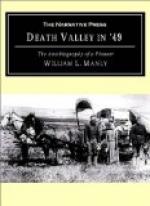When the raft was landed on the west bank, the mule packed, and all about ready to start, I took the long strip of raw-hide from the raft and tied one end of it around the mule’s neck, mounted Field on the mule behind the large pack, which made the whole outfit look quite comical indeed. Before leaving the other side of the river I had discovered that the saddle girth was not very strong, so I cut a wide belt from the hide of the lately slaughtered horse and fitted it to the saddle as a girth, knowing that the pack, now containing all of our goods and a supply of more than a bushel of jerk, would be quite bulky, if not heavy, and more difficult to keep on the back of a mule than it is for the camel to maintain his hump on his back. This girth afterwards made us two or three pretty substantial meals, as did also the long strip of green, wet hide, one end of which I had tied round the mule’s neck, allowing it to drag for a long distance through the hot dry sand.
All being ready, I, as usual, took the lead with my shot gun, which I always carried, but with which I seldom killed anything, on my shoulder. The old mule followed with his high, towering pack, and Field almost hidden behind. It was noon, but we did not stop for dinner, but simply reached into one of the great bulging sacks, took out a piece of jerk and ate it as we went marching on; no more trouble now about cooking. Late in the afternoon we reached Uinta river, and, as my two-legged companion had grown very tired of the back of the four-legged one, we went into camp early. Our objective point was Fort Uinta, where we hoped to find military. We could not risk turning the mule loose at night, and the long strip of raw-hide was designed and used to secure him, and yet to afford him liberty to graze while we slept. As you will see a little further on, both girth and lariat were used for a purpose not anticipated.
The second, third, fourth, and fifth days came and went, and we were trudging on, up the Uinta, through a mostly very barren country, with some little rich and fertile land. We saw signs of Indians often, but no Indians. There was much cottonwood, but little other timber. We saw some fish in the river which we coveted, but could not get. The main course of this river is from north-west to south-east. We traveled most of the way to the fort on Indian trails, some of which were much worn, but mostly at some much earlier period. Of course we had plenty of good water, and food, such as it was. Field did not walk two miles during those five days, but seemed to be fattening fast. I sometimes thought he might be just a little lazy, but I never told him so, for I realized that he had recently had a severe tussle with death.




